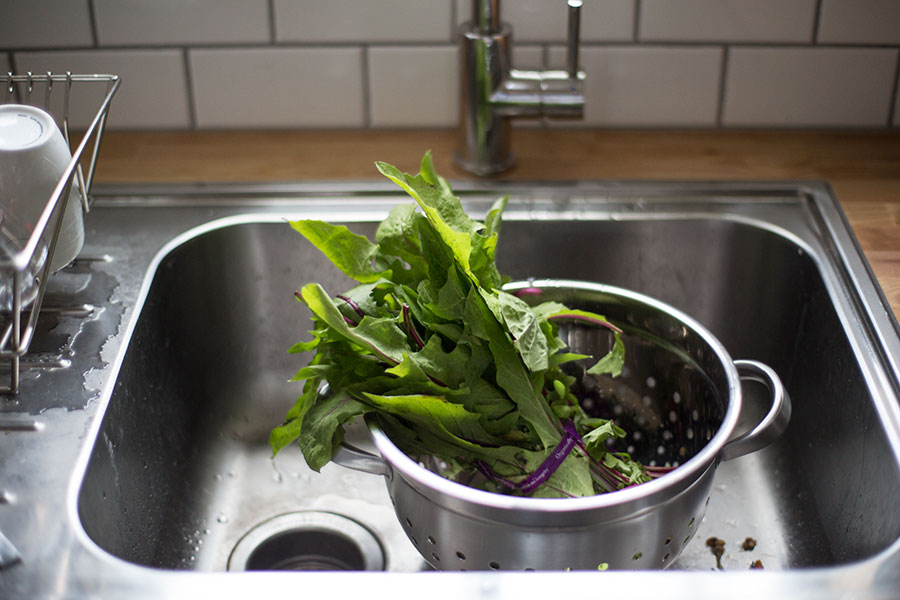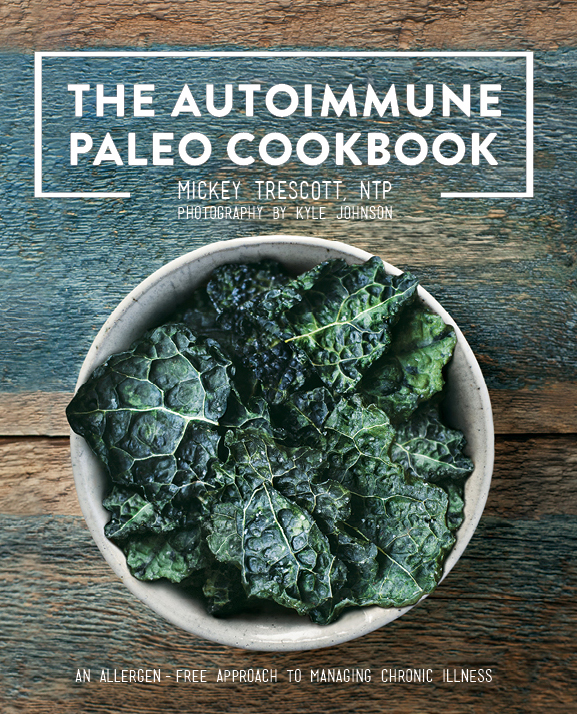Last April I released AIP Batch Cook, a video-based training program that teaches you how to prepare all of the food you need for a week in just two sessions. This article is meant to teach you the basics, but if you are still looking for more instruction be sure to check it out!
What is “batch cooking”?
This term refers to the practice of cooking a lot of meals in “batches” and then either freezing or storing the leftovers to be reheated or used as components for quick meal assembly.
Exactly how much time does it save?
Batch cooking can save some serious time in the kitchen. I timed myself cooking meals mostly from scratch for one week, and I was shocked to find this can take 20-30 hours including cleanup. With a super organized batch cooking routine (like the one I propose in AIP Batch Cook) you can get that down to just 4-5 hours a week.
My current routine is somewhere in the middle — I really enjoy cooking and it doubles as a pleasurable, stress-relieving activity for me. I spend about 10 hours a week in the kitchen and aim to batch-cook a few big soups/stews as well as protein to be used to assemble salads or breakfast skillets on-the-go.
Wherever you are at, below you will find some of my best tips and tricks for planning and executing a batch-cooking routine!
5 tips to plan your batch-cooking session:
- Cook multiple dishes that call for the same oven temperature. Unless you have two ovens (lucky!) you are not going to be able to cook two dishes at different oven temps. For instance, I like to pick out a vegetable and a meat recipe that call for the same oven temp (like my Rainbow Roasted Root Vegetables and Ginger-Baked Salmon).
- Think through your tool limitations when planning your session. If you have two recipes that use your skillet, make sure to carefully plan how long it will be in use to make sure it is realistic to use it again (especially considering cooling and cleaning time). Do you have a pot big enough to make a doubled recipe of “Magic” Chili? Find this out before you start cooking.
- Make sure to order or pick up any essentials before the session. While you don’t need to have a bunch of fancy tools or an amazing kitchen to be successful at batch-cooking, there are a few minimum items you will need, like storage containers to keep the food when it is finished. Give thought to these and make sure to have them on hand before you begin.
- Pick out all of your recipes. I’ve added a section with further tips down below.
- Make a meal plan for the week. Print out a calendar page and write down which recipes you plan to eat for breakfast, lunch and dinner every day. Plan your grocery and batch-cooking sessions for when you have time to execute them.
6 tips to picking out recipes for a batch-cooking session:
- Select recipes that are one-pot. Minimizing recipes that call for a lot of cooking vessels is going to make things much easier to coordinate, as well as clean up at the end of the session. I prefer soups/stews for this reason, especially when the sautéing can be done in the same pot at the beginning of the recipe.
- Select recipes that contain complete meals. It makes the best use of your time if you make meals that are complete meals instead of a bunch of sides. I always start by planning a soup, stew, or skillet as the core of the routine and then see which sides fit in as opposed to the other way around.
- Select meat recipes that can save time later. By cooking something like a chicken or a pot roast, you end up with a hunk of protein that you can use to make a super quick meal later in the week. Shredded meat can be added to a salad, stir-fry, or to make a quick soup with vegetables.
- Select recipes that are simple and intuitive. This is not the time to try out a new complex recipe—think basic and doable. Avoid recipes that have a lot of steps and a large margin of error.
- Take into account storage capabilities. Something like Bone Broth will last a week in the refrigerator, while fish is only going to last a day or two. Some recipes freeze well, others need to be eaten fresh. Take this into account when choosing a recipe!
- Focus on nutrient-dense meals and not treats. I don’t include treat recipes in my batch-cooking sessions and choose to focus on those that are going to be the most nourishing to my body.
5 tips to execute your batch-cooking session:
- Start with a clean kitchen, and make sure that all of your countertops are free from clutter. Because you will be going through a lot of volume of food and making a lot of dishes, it is best to start fresh to avoid overwhelm later.
- Chop all of your ingredients before you start cooking. This will make it far easier to follow recipes, especially when you have more than one dish cooking at a time.
- Use a timer. This is not a good time to “wing it,” especially if you have a lot of meals cooking at once.
- Clean as you go. You will be surprised at how much time you have while your food cooks—be prudent and use this time to take mini cleaning breaks. It will make the job so much easier at the end, and dishes are far easier to clean when they are freshly dirty.
- Pack your meals in portion-size containers. This makes it easy to see how many meals you have ready to go.
Batch-cooking itself is not that difficult—I find the planning and organization that comes before the actual cooking to be the hardest part. I hope that this guide has given you some ideas for how you can plan and execute in a way that sets you up for success!
If you are still looking for help, check out this free video, as well as my program AIP Batch Cook, where I teach you how to accomplish this with real-time video instruction.
Do you employ batch cooking as a way to make the Autoimmune Protocol more doable? Share your best tips in the comments section!

















23 comments
Thank you so much for these tips! Do you guys have any advice on freezer storage? I just got a freezer and finally have space to batch cook!! : ) What kinds of containers work the best to prevent freezer burn? Also wondering if I thaw a pkg of meat from my processor, is it safe to refreeze into smaller portions? Any freezing tips and advice are appreciated!
Melissa,
I like to use wide-mouth pint-size ball jars to freeze broth and soups/stews. It is very important not to fill past the fill line or they will overflow or crack! Raw meat should not be thawed and then refrozen, but you can thaw, cook, and then freeze the cooked meat. I like to keep bones and portions of meat I save in ziploc bags. I never put anything hot into plastic anything (even if it is BPA-free). Hope it helps!
[…] Batch Cooking 101 – Autoimmune Paleo […]
[…] consider batch cooking -taking a day to make and prep multiple meals to eat or freeze for later. (Here is a great resource if you’re interested in batch cooking.) Also, if you’ve made something (especially a protein-think pot roast, chicken, etc) and you […]
Mickey, your tips and video were incredibly helpful. My husband and I just did our first AIP batch cook session and it was great – like a mini date night! We’re looking forward to having healthful meal options stored in the fridge for the upcoming week. Thank you so much for the resources you provide and the work you do.
So happy you guys liked it Riley! Wishing you both luck!
[…] Mickey’s tips on batch cooking can be found here […]
Hi Mickey, I wanted to ask you can you freeze any of your meals for a month. I would like to freeze meals for up to 30 days. I read that it usually a 2 day cooking plan.but it is worth it if I can freeze 30 meals instead of weekley. And which of your books would be good for me that have breakfast,lunch,dinner and dessert recipes . thanks and love your website.I also have a autoimmune disease and it really affects my digestive system along with all my other organs.take care of yourselves and hope to hear from you soon.thanks
Hi Lee Ann, yes you can absolutely freeze meals and as long as they are sealed well last 2-3 months in the fridge. I recommend soups, stews, curries, etc. as they will freeze well. We have tons of recipes in the archives as well as in our books. Good luck!
[…] Batch cooking 101 with Mickey Trescott from Autoimmune Paleo […]
[…] I dollop that on top of my salad. These selections feature a recipes that would be easy to batch-cook for dinners at the beginning of the week and top up my lunch […]
Hi, Love this article! My only concern before I start batch cooking is I need to keep everything low histamine as I itch with leftovers. Ideas for things I can batch cook and freeze that can hold up in the freezer are appreciated.
Thanks again for encouraging us as we delve into healing our bodies through food and healthy choices.
Hi Jeniver!
Most of the soup/stew recipes you will find on this site are perfectly suitable for freezing! Just check out the recipe archives. Wishing you the best.
[…] breakfast, and keeping enough compliant food on hand to avoid “The Hungries.” This batch-cooking recipe solves both problems. With breakfast for days in fridge and freezer, you’ll […]
Hey there, Mickey… Do you have any advice for someone who lives in a house with 5 other people and we all share a fridge and freezer? I would like to start batch cooking but I’m afraid I just won’t have the space for it.
Sara – You can totally make it happen with some creative organizing! I own a 1/2 size fridge and I still find room to store my batch cooking with the reduced space. You will be surprised to find out how much stuff lives in the fridge that nobody uses/eats (condiments!) and how much space a clear-out can produce. Good luck!
[…] I will make a more detailed post about what I actually do with regards to batch cooking soon. In the meantime, this is very American-centric, but you’ll see what I mean here. […]
I’m so eager to buy this especially at the new reduced price (thank you!) but each time I try, an “inactive/no longer for sale” message pops up. Please help!
Hi there! The program is not available right now as we are in the middle of a website overhaul. It should be back in a month or two! Sorry!
[…] diseases come with lower energy levels or pain and stiffness in the AM. Mickey does a round of batch cooking once or twice a week and always incorporates breakfast items. Some great options are protein […]
[…] Batch-cooking. You could spend hours every day prepping and cooking a meal, or you could spend 4(ish) hours on a weekend and batch cook all of your meals for the next week. Boom. […]
The AIP Batch cook video was there and now it’s gone! When I click on the link, the website isn’t working. Is this still available for purchase? Thank you!
Hi Kristen! You can find AIP Batch Cook here: http://www.aipbatchcook.com.